| 登録情報 | データベース: PDB / ID: 5k58
|
|---|
| タイトル | Structure of the K. pneumonia SlmA-DNA complex bound to the C-terminal of the cell division protein FtsZ |
|---|
 要素 要素 | - DNA (5'-D(*GP*TP*GP*AP*GP*TP*AP*CP*TP*CP*AP*C)-3')
- Nucleoid occlusion factor SlmA
- Octapeptide
|
|---|
 キーワード キーワード | DNA BINDING PROTEIN/DNA / SlmA / DNA / FtsZ / nucleoid occlusion / DNA BINDING PROTEIN-DNA complex |
|---|
| 機能・相同性 |  機能・相同性情報 機能・相同性情報
negative regulation of protein polymerization / division septum site selection / negative regulation of division septum assembly / divisome complex / bacterial nucleoid / division septum assembly / FtsZ-dependent cytokinesis / cell division site / protein polymerization / sequence-specific DNA binding ...negative regulation of protein polymerization / division septum site selection / negative regulation of division septum assembly / divisome complex / bacterial nucleoid / division septum assembly / FtsZ-dependent cytokinesis / cell division site / protein polymerization / sequence-specific DNA binding / transcription cis-regulatory region binding / DNA-binding transcription factor activity / cell division / GTPase activity / regulation of DNA-templated transcription / GTP binding / protein homodimerization activity / DNA binding / identical protein binding / plasma membrane / cytoplasm類似検索 - 分子機能 Nucleoid occlusion factor SlmA / : / Tetracyclin repressor-like, C-terminal domain / Cell division protein FtsZ / Cell division protein FtsZ, conserved site / Cell division protein FtsZ, C-terminal / FtsZ family, C-terminal domain / FtsZ protein signature 1. / FtsZ protein signature 2. / Tubulin-like protein FtsZ/CetZ ...Nucleoid occlusion factor SlmA / : / Tetracyclin repressor-like, C-terminal domain / Cell division protein FtsZ / Cell division protein FtsZ, conserved site / Cell division protein FtsZ, C-terminal / FtsZ family, C-terminal domain / FtsZ protein signature 1. / FtsZ protein signature 2. / Tubulin-like protein FtsZ/CetZ / DNA-binding HTH domain, TetR-type, conserved site / TetR-type HTH domain signature. / : / Tetracycline Repressor, domain 2 / Tetracyclin repressor-like, C-terminal domain superfamily / Tetracycline Repressor; domain 2 / Bacterial regulatory proteins, tetR family / DNA-binding HTH domain, TetR-type / TetR-type HTH domain profile. / Tubulin/FtsZ family, C-terminal domain / Tubulin/FtsZ-like, C-terminal domain / Tubulin/FtsZ, C-terminal / Tubulin/FtsZ, 2-layer sandwich domain / Tubulin/FtsZ family, GTPase domain / Tubulin/FtsZ family, GTPase domain / Tubulin/FtsZ, GTPase domain / Tubulin/FtsZ, GTPase domain superfamily / Homeobox-like domain superfamily / Orthogonal Bundle / Mainly Alpha類似検索 - ドメイン・相同性 DNA / DNA (> 10) / Nucleoid occlusion factor SlmA / Cell division protein FtsZ / Nucleoid occlusion factor SlmA類似検索 - 構成要素 |
|---|
| 生物種 |   Escherichia coli O139:H28 (大腸菌) Escherichia coli O139:H28 (大腸菌)
Synthetic construct (人工物) |
|---|
| 手法 |  X線回折 / X線回折 /  シンクロトロン / シンクロトロン /  分子置換 / 解像度: 2.772 Å 分子置換 / 解像度: 2.772 Å |
|---|
 データ登録者 データ登録者 | Schumacher, M. |
|---|
 引用 引用 |  ジャーナル: Proc. Natl. Acad. Sci. U.S.A. / 年: 2016 ジャーナル: Proc. Natl. Acad. Sci. U.S.A. / 年: 2016
タイトル: Structures of the nucleoid occlusion protein SlmA bound to DNA and the C-terminal domain of the cytoskeletal protein FtsZ.
著者: Schumacher, M.A. / Zeng, W. |
|---|
| 履歴 | | 登録 | 2016年5月23日 | 登録サイト: RCSB / 処理サイト: RCSB |
|---|
| 改定 1.0 | 2016年6月22日 | Provider: repository / タイプ: Initial release |
|---|
| 改定 1.1 | 2024年3月6日 | Group: Data collection / Database references / Derived calculations
カテゴリ: chem_comp_atom / chem_comp_bond ...chem_comp_atom / chem_comp_bond / database_2 / pdbx_struct_oper_list
Item: _database_2.pdbx_DOI / _database_2.pdbx_database_accession / _pdbx_struct_oper_list.symmetry_operation |
|---|
|
|---|
 データを開く
データを開く 基本情報
基本情報 要素
要素 キーワード
キーワード 機能・相同性情報
機能・相同性情報
 X線回折 /
X線回折 /  シンクロトロン /
シンクロトロン /  分子置換 / 解像度: 2.772 Å
分子置換 / 解像度: 2.772 Å  データ登録者
データ登録者 引用
引用 ジャーナル: Proc. Natl. Acad. Sci. U.S.A. / 年: 2016
ジャーナル: Proc. Natl. Acad. Sci. U.S.A. / 年: 2016 構造の表示
構造の表示 Molmil
Molmil Jmol/JSmol
Jmol/JSmol ダウンロードとリンク
ダウンロードとリンク ダウンロード
ダウンロード 5k58.cif.gz
5k58.cif.gz PDBx/mmCIF形式
PDBx/mmCIF形式 pdb5k58.ent.gz
pdb5k58.ent.gz PDB形式
PDB形式 5k58.json.gz
5k58.json.gz PDBx/mmJSON形式
PDBx/mmJSON形式 その他のダウンロード
その他のダウンロード 5k58_validation.pdf.gz
5k58_validation.pdf.gz wwPDB検証レポート
wwPDB検証レポート 5k58_full_validation.pdf.gz
5k58_full_validation.pdf.gz 5k58_validation.xml.gz
5k58_validation.xml.gz 5k58_validation.cif.gz
5k58_validation.cif.gz https://data.pdbj.org/pub/pdb/validation_reports/k5/5k58
https://data.pdbj.org/pub/pdb/validation_reports/k5/5k58 ftp://data.pdbj.org/pub/pdb/validation_reports/k5/5k58
ftp://data.pdbj.org/pub/pdb/validation_reports/k5/5k58 リンク
リンク 集合体
集合体
 要素
要素

 X線回折 / 使用した結晶の数: 1
X線回折 / 使用した結晶の数: 1  試料調製
試料調製 シンクロトロン / サイト:
シンクロトロン / サイト:  ALS
ALS  / ビームライン: 8.3.1 / 波長: 1 Å
/ ビームライン: 8.3.1 / 波長: 1 Å 分子置換
分子置換 解析
解析 分子置換 / 解像度: 2.772→43.435 Å / 交差検証法: FREE R-VALUE / σ(F): 1.97 / 位相誤差: 39.75
分子置換 / 解像度: 2.772→43.435 Å / 交差検証法: FREE R-VALUE / σ(F): 1.97 / 位相誤差: 39.75  ムービー
ムービー コントローラー
コントローラー







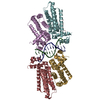
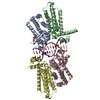
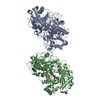
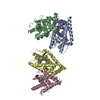


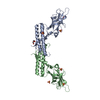
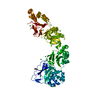
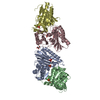
 PDBj
PDBj









































